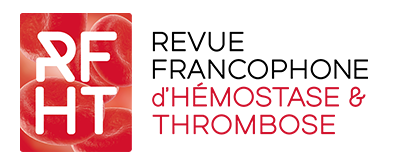RÉSUMÉ
L’hémophilie A et l’hémophilie B sont des maladies induites par un déficit en facteur VIII (FVIII) et facteur IX (FIX) respectivement, avec une production insuffisante de thrombine provoquant des saignements. De nouvelles thérapies pour l’hémophilie basées sur la neutralisation de protéines anticoagulantes endogènes voient le jour. Notre cible, la protéase nexine-1 (PN-1), est une serpine capable d’inhiber fortement la thrombine, exprimée principalement par les plaquettes. Nos travaux montrent qu’inhiber la PN-1 par un anticorps neutralisant augmente significativement la génération de thrombine dans des plasmas de patients hémophiles mineurs ou modérés. Chez des souris hémophiles A, l’absence de PN-1 réduit significativement le temps de saignement et le volume de sang perdu. Des expériences de thrombose sur vaisseaux mésentériques montrent que l’absence de PN-1 chez ces souris hémophiles augmente significativement les dépôts de fibrine et de plaquettes. De plus, la fermeté des caillots est significativement plus élevée, et la lyse retardée dans le sang de ces souris, mais aussi dans celui de patients hémophiles A incubé avec un anticorps bloquant la PN-1. Ces résultats fournissent la preuve de concept qu’inhiber la PN-1 pourrait être une nouvelle approche originale dans le traitement de l’hémophilie.
MOTS CLÉS
anticoagulant, hémophilie, protéase nexine-1, thrombine
ABSTRACT
Haemophilia A and haemophilia B are diseases caused by a deficiency in factor VIII (FVIII) and factor IX (FIX) respectively, leading to insufficient thrombin production, and therefore to bleedings. New therapeutic strategies for haemophilia based on the neutralization of endogenous anticoagulant proteins can be proposed. Protease nexin-1 (PN-1) is a serpin, potent inhibitor of thrombin, mainly expressed in platelets. We recently showed that a PN-1-neutralizing antibody could significantly shorten the thrombin burst in response to tissue factor in platelet rich plasma (PRP) from patients with mild or moderate haemophilia. ln various bleeding models, haemophilia A mice deficient in PN-1 (F8-/-/PN-1-/-) display significantly reduced blood loss and bleeding time compared to haemophilic mice (F8-/-). Moreover, platelet recruitment and fibrin(ogen) accumulation are significantly higher in F8-/-/PN-1-/- mice than in F8-/- mice in mesenteric vessel thrombosis model. Further studies showed enhanced dot stability and increased dot lysis time in blood from F8-/-/PN-1-/- and from haemophilia A patients incubated with a PN-1-neutralizing antibody, compared to their respective controls. Our study thus provided proof-of-concept that PN-1 neutralization can be a novel approach for future clinical care in haemophilia.
KEYWORDS
anticoagulant, haemophilia, protease nexin-1, thrombin

